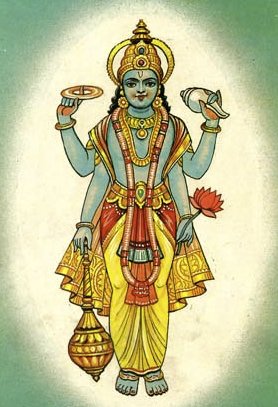Sharanagati, Śaraṇāgati, Sharana-agati: 6 definitions
Introduction:
Sharanagati means something in Hinduism, Sanskrit. If you want to know the exact meaning, history, etymology or English translation of this term then check out the descriptions on this page. Add your comment or reference to a book if you want to contribute to this summary article.
The Sanskrit term Śaraṇāgati can be transliterated into English as Saranagati or Sharanagati, using the IAST transliteration scheme (?).
Images (photo gallery)
In Hinduism
Purana and Itihasa (epic history)
Source: Cologne Digital Sanskrit Dictionaries: The Purana IndexŚaraṇāgati (शरणागति).—The act of falling at the feet of the Devī for protection, sixfold.*
- * Brahmāṇḍa-purāṇa IV. 41. 74-81.

The Purana (पुराण, purāṇas) refers to Sanskrit literature preserving ancient India’s vast cultural history, including historical legends, religious ceremonies, various arts and sciences. The eighteen mahapuranas total over 400,000 shlokas (metrical couplets) and date to at least several centuries BCE.
Vaishnavism (Vaishava dharma)
Source: Pure Bhakti: Bhagavad-gita (4th edition)Śaraṇāgati (शरणागति) refers to “surrender. The six symptoms of surrender (śaraṇa) are (a) acceptance of anything that fosters the growth of the creeper of devotion, (b) avoidance of anything that hinders that growth, (c) the firm faith that Śrī Śrī Rādhā-Kṛṣṇa will always extend the protective umbrella of Their lotus feet over Their devoted servants, (d) acceptance of Their Lordships as one’s exclusive guardians, (e) submissive offering of one’s full self at Their lotus feet and (f) always feeling one’s self lowly and humble”. (cf. Glossary page from Śrīmad-Bhagavad-Gītā).
Source: Pure Bhakti: Bhajana-rahasya - 2nd EditionŚaraṇāgati (शरणागति) refers to:—Surrender; approaching for refuge or protection: (1) to accept that which is favourable for kṛṣṇa-bhakti; (2) to reject that which is unfavourable; (3) to have faith ‘Bhagavān will protect me’;(4) to have dependence, thinking ‘Bhagavān will take care of me’; (5) to be fully self-surrendered (ātma-samarpaṇa); and (6) to be humble, feeling insignificant and very fallen. (cf. Glossary page from Bhajana-Rahasya).

Vaishnava (वैष्णव, vaiṣṇava) or vaishnavism (vaiṣṇavism) represents a tradition of Hinduism worshipping Vishnu as the supreme Lord. Similar to the Shaktism and Shaivism traditions, Vaishnavism also developed as an individual movement, famous for its exposition of the dashavatara (‘ten avatars of Vishnu’).
Languages of India and abroad
Sanskrit dictionary
Source: DDSA: The practical Sanskrit-English dictionaryŚaraṇāgati (शरणागति).—approach for protection.
Derivable forms: śaraṇāgatiḥ (शरणागतिः).
Śaraṇāgati is a Sanskrit compound consisting of the terms śaraṇa and āgati (आगति).
Source: Cologne Digital Sanskrit Dictionaries: Monier-Williams Sanskrit-English DictionaryŚaraṇāgati (शरणागति):—[from śaraṇa] f. approach for pr°
Sanskrit, also spelled संस्कृतम् (saṃskṛtam), is an ancient language of India commonly seen as the grandmother of the Indo-European language family (even English!). Closely allied with Prakrit and Pali, Sanskrit is more exhaustive in both grammar and terms and has the most extensive collection of literature in the world, greatly surpassing its sister-languages Greek and Latin.
Kannada-English dictionary
Source: Alar: Kannada-English corpusŚaraṇāgati (ಶರಣಾಗತಿ):—
1) [noun] the act, fact or an instance of seeking refuge and protection.
2) [noun] a complete submission of oneself to a god, spiritual teacher, etc.
Kannada is a Dravidian language (as opposed to the Indo-European language family) mainly spoken in the southwestern region of India.
See also (Relevant definitions)
Partial matches: Sharana, Agati.
Starts with: Sharanagatidipika, Sharanagatigadya, Sharanagatitatparyashlokopanyasa.
Ends with: Vaishnavasharanagati.
Full-text: Sharanagatigadya, Sharanagatitatparyashlokopanyasa, Sharanagatidipika, Vaishnavasharanagati.
Relevant text
Search found 19 books and stories containing Sharanagati, Śaraṇāgati, Sharana-agati, Saranagati, Śaraṇa-āgati, Sarana-agati; (plurals include: Sharanagatis, Śaraṇāgatis, agatis, Saranagatis, āgatis). You can also click to the full overview containing English textual excerpts. Below are direct links for the most relevant articles:
Bhajana-Rahasya (by Srila Bhaktivinoda Thakura Mahasaya)
Text 2 < [Chapter 3 - Tṛtīya-yāma-sādhana (Pūrvāhna-kālīya-bhajana–niṣṭhā-bhajana)]
Text 33 < [Chapter 1 - Prathama-yāma-sādhana (Niśānta-bhajana–śraddhā)]
Text 2 < [Chapter 4 - Caturtha-yāma-sādhana (Madhyāhna-kālīya-bhajana–ruci-bhajana)]
Shrimad Bhagavad-gita (by Narayana Gosvami)
Verse 18.66 < [Chapter 18 - Mokṣa-yoga (the Yoga of Liberation)]
Verse 15.5 < [Chapter 15 - Puruṣottama-toga (Yoga through understanding the Supreme Person)]
Verse 18.78 < [Chapter 18 - Mokṣa-yoga (the Yoga of Liberation)]
Prasthanatrayi Swaminarayan Bhashyam (Study) (by Sadhu Gyanananddas)
6. Śaraṇāgati (Refuge) < [Chapter 4 - Analysis on the Basis of Spiritual Endeavour]
6.1. Guru-śaraṇāgati < [Chapter 4 - Analysis on the Basis of Spiritual Endeavour]
Tiruvaymoli (Thiruvaimozhi): English translation (by S. Satyamurthi Ayyangar)
Pasuram 1.10.2 < [Section 10 - Tenth Tiruvaymoli (Poru ma nil patai)]
Pasuram 10.1.2 < [Section 1 - First Tiruvaymoli (Tala tamarai)]
Pasuram 1.1.11 < [Section 1 - First Tiruvaymoli (Uyarvu ara Uyar Nalam)]
Siddhanta Sangraha of Sri Sailacharya (by E. Sowmya Narayanan)
